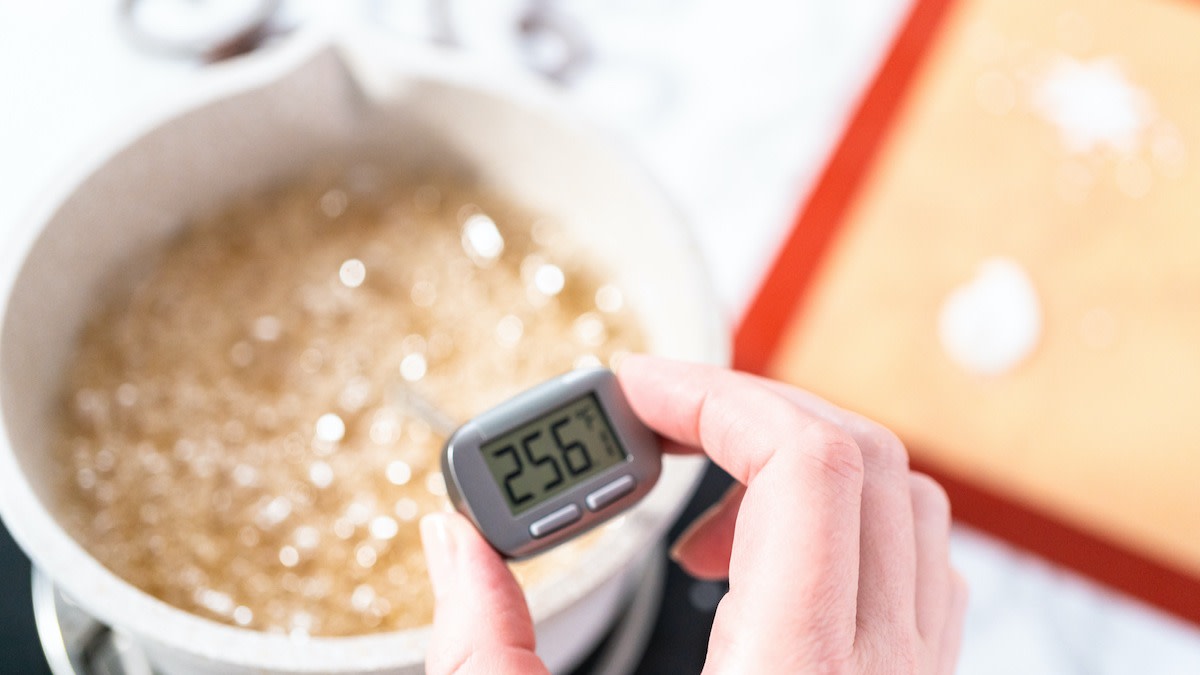Hard-Ball vs. Soft-Crack Stages of Sugar Explained
Written by MasterClass
Last updated: Dec 20, 2021 • 4 min read
When you boil sugar in water to make candy, the sugar goes through several predictable stages, two of which are the hard-ball and soft-crack stages.
Learn From the Best
What Is the Hard-Ball Stage of Sugar?
The hard-ball stage of sugar is when heated sugar syrup reaches a thick consistency that holds its shape when cooled in cold water. If you pour melted sugar from the pan into cold water, you can form it into a ball that will not flatten on its own. This stage occurs between 250 and 266 degrees Fahrenheit. Sugar at the hard-ball stage is useful for soft nougat and marshmallows.
What Is the Soft-Crack Stage of Sugar?
Cooked sugar reaches the soft-crack stage between 270 and 290 degrees Fahrenheit. In this stage, the syrup's concentration of sugar reaches ninety-five percent, with most of the syrup's water having boiled away. By this stage, the bubbles in the sugar syrup have become very small and concentrated.
When threads of sugar are cooled at the soft-crack stage, they will be somewhat pliable and will bend before they crack. Candies made at the soft-crack stage typically have a crunchy texture that's pleasing to chew, and they often have a caramel flavor. Among the types of candy cooked to the soft-crack stage are saltwater taffy, firm nougat, toffee, and butterscotch.
Hard-Ball vs. Soft-Crack: What’s the Difference?
The difference between hard-ball and soft-crack sugar lies in its temperature and texture. Sugar syrup goes through the hard-ball stage, from 250–266 degrees Fahrenheit, before reaching the soft-crack stage, which ranges from 270–290 degrees Fahrenheit.
Sugar moves from one stage to the next as the water boils away, increasing the concentration of sugar within the syrup. When moving from the hard-ball to soft-crack stage, the sugar concentration increases from ninety-two percent to ninety five percent.
6 Stages of Cooked Sugar
The behavior of boiling sugar during the cold water test corresponds to a specific temperature range:
- 1. Thread stage (215–235 degrees Fahrenheit): When you remove some syrup from the pan, it forms a thin thread in the air. The thread stage is for syrups and preserves.
- 2. Soft-ball stage (235–240 degrees Fahrenheit): When you transfer a small amount of syrup to cold water, it forms a soft, pliable ball. Sugar at this stage is used for fondant, fudge, pralines, and Italian meringue.
- 3. Firm-ball stage (245–250 degrees Fahrenheit): When syrup transfers to cold water, it forms a firm ball. This type of sugar is ideal for caramel candies.
- 4. Hard-ball stage (240–265 degrees Fahrenheit): The hard-ball stage is for marshmallows and nougat. When you transfer a small amount of syrup to cold water, it forms a hard ball.
- 5. Soft-crack stage (270–290 degrees Fahrenheit): When you add a small amount of syrup to cold water, it makes a soft cracking noise and forms pliable threads. The soft-crack stage is for candies such as taffy and butterscotch.
- 6. Hard-crack stage (300 degrees Fahrenheit and above): A small amount of syrup added to cold water makes a loud cracking noise and separates into brittle threads. The hard-crack stage is for toffee and hard candies like lollipops. Above 330 degrees Fahrenheit, the sugar begins to caramelize and brown.
How to Use a Candy Thermometer When Making Candy
One of the most common ways to tell what stage your syrup has reached is by using a candy thermometer to check the candy temperature. If you're at altitude, rather than sea level, your thermometer may not be accurate. In addition, candy thermometers can lose their precision over time, so you should recalibrate your thermometer at least once a year. To do this, place it in water as you heat it to the boiling point, and check to see that the thermometer registers 212 degrees Fahrenheit in the boiling water. If you're cooking with an inaccurate candy thermometer, you're likely to have significant problems with your candy making, since reaching the desired temperature accurately is key.
How to Use a Cold Water Test When Making Candy
When you're cooking sugar syrup, you can test its stage by using the cold water method. To determine whether your sugar syrup has reached the hard-ball stage, drop a spoonful of syrup into very cold water. Reach into the water to form the syrup into a ball. If it forms and holds its shape as a ball, retaining most of its shape as you press it, you've reached the hard-ball stage.
The cold-water test also helps you determine whether your sugar syrup has reached the soft-crack stage. Again, drop a spoonful of hot syrup into very cold water. When the syrup forms pliable threads that you can pull apart with your finger, your syrup is at the soft-crack stage. The threads should bend before they crack and break. If the brittle threads break right away without bending, your sugar has moved on to the hard-crack stage.
Want to Learn More About Cooking?
Become a better chef with the MasterClass Annual Membership. Gain access to exclusive video lessons taught by the world’s best, including Alice Waters, Gabriela Cámara, Niki Nakayama, Chef Thomas Keller, Gordon Ramsay, Yotam Ottolenghi, Dominique Ansel, and more.
